Have you ever thought about teaching your Bengal cat to use a cat door? Melis Mandal’s story will change your mind. Her Bengal cat, Simba, shows just how smart and capable these cats are. Training a Bengal cat isn’t a far-off idea; it’s a close and rewarding process.
Imagine your lively Bengal cat moving in and out freely. This can happen with a few simple but powerful training methods.
Key Takeaways
- Bengal cats like Simba can quickly learn complex actions, proving their high trainability.
- Dedicated training can unlock potential beyond the average feline’s abilities.
- With the right approach, training Bengal cats to use a cat door is entirely feasible.
- The breed’s intelligence and curiosity make them ideal candidates for indoor training.
- Success in cat door training hinges on consistency and positive reinforcement.
Understanding Your Bengal Cat’s Unique Traits
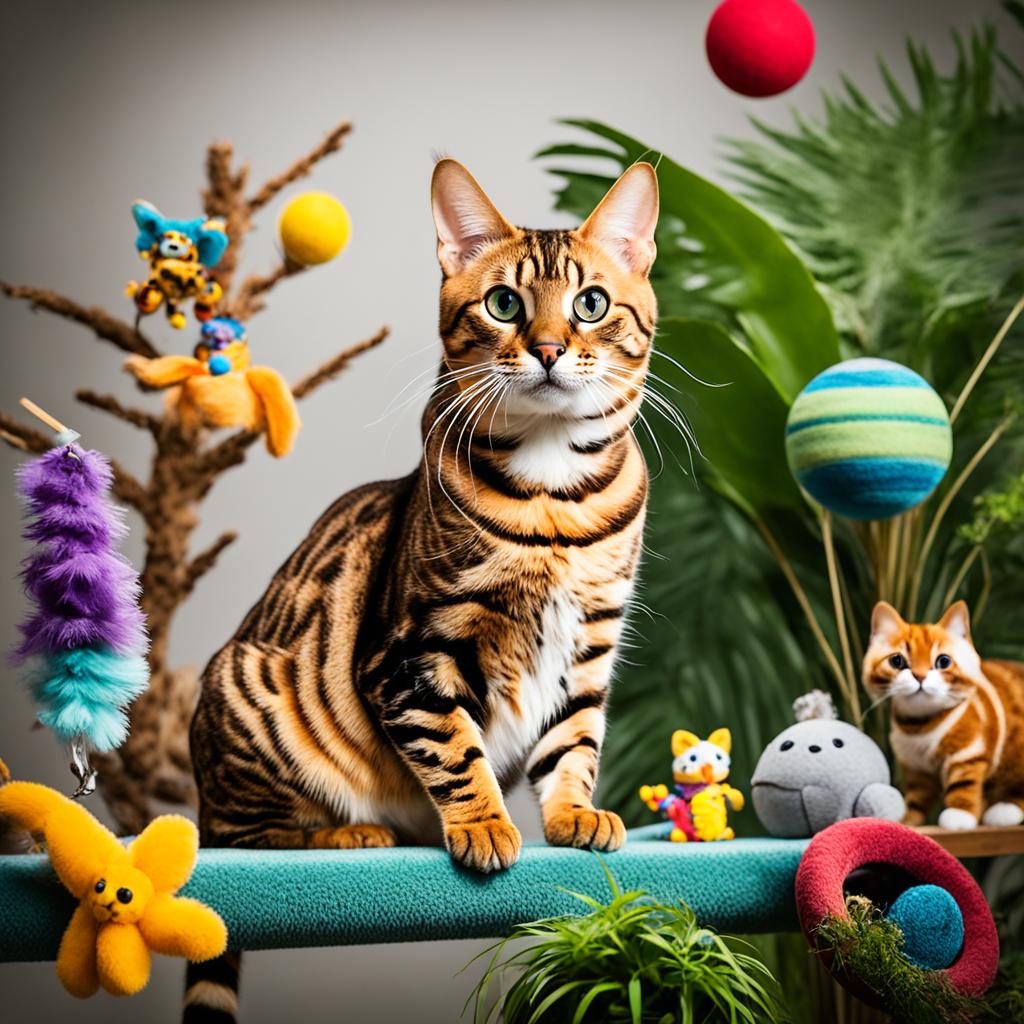
When we talk about Bengal cats, we enter a world of special traits. These pets are not just beautiful. They have unique personalities. This means they are more than looks. We will explore what makes Bengal cats unique and how to train them well.
Intelligence and Curiosity
Bengal cats stand out with their sharp minds. They are curious and like to check out new things. Using their curiosity in training is fun and smart. Cats like Simba and Lucy catch on quickly and love learning new tricks. This makes training them a fun experience for both you and the cat.
High Energy Levels
Bengal cats have more energy than you might expect from a cat. They need activity to stay happy. Training that is fun and interactive is best for them. With the right approach, you can use their love for movement in training. This makes the training not just successful but also enjoyable.
Natural Hunting Instincts
Bengal cats have a strong hunting drive from their wild ancestors. This means they like games that mimic hunting. Using toys like fishing poles can keep them interested. It’s important to know this when training them.
Understanding your Bengal cat’s unique traits can make all the difference in training. It can help in simple things like teaching them to use a cat door. By recognizing their cleverness, energy, and hunting nature, you can make training enjoyable. It is about working with what makes your Bengal cat stand out. This makes training good for you both.
Benefits of Training Your Bengal Cat
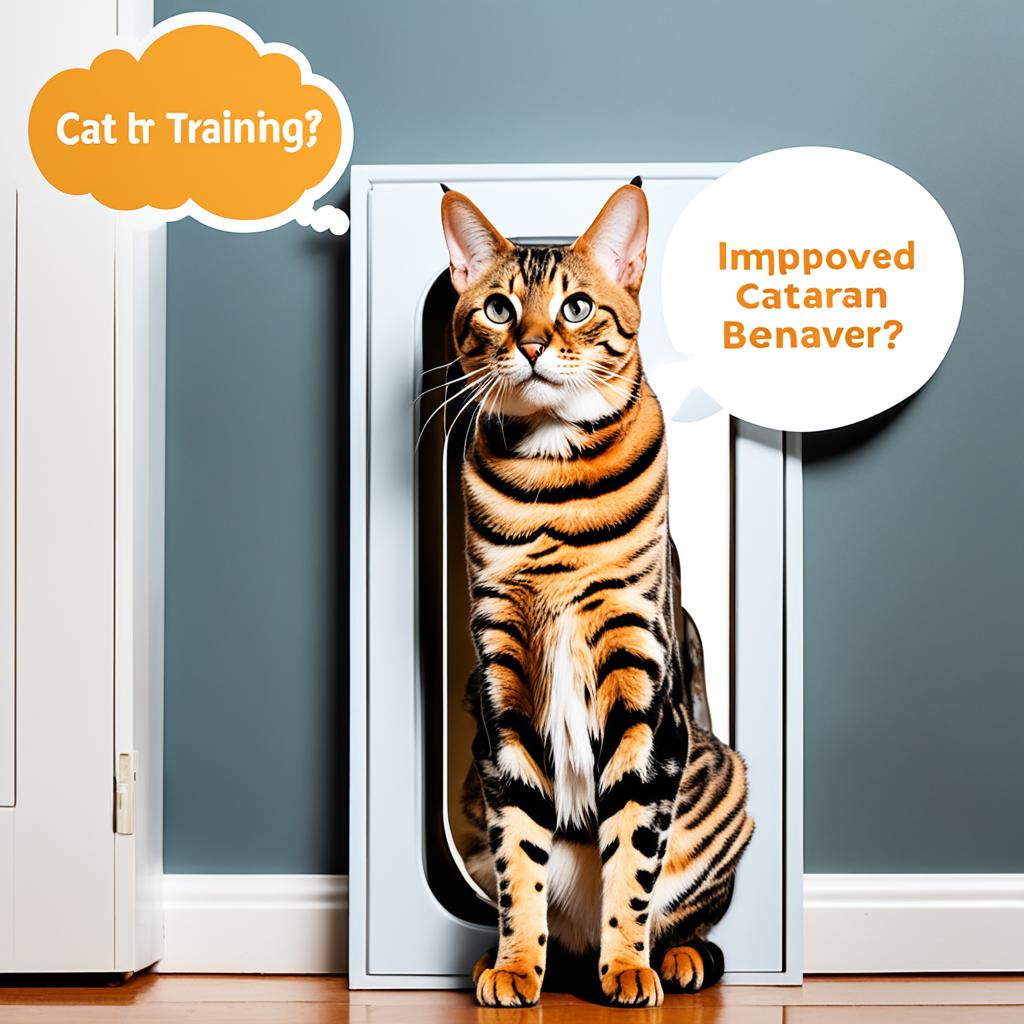
Training your Bengal cat can make both your lives better. Teaching them skills like using a cat door is good for their mind. It keeps them thinking and happy.
Mental Stimulation and Enrichment
Training helps Bengal cats stay mentally sharp. Bengal cats love to learn new things. It makes them happier and healthier.
Increased Bond with Your Cat
Training also makes your bond stronger. It improves how you and your cat talk to each other. This shared learning time builds trust and a better connection.
Training does more than teach tricks. It makes your relationship with your pet more fulfilling. It’s good for their life and yours.
Why Bengal Cats Can Learn to Use a Cat Door Easily
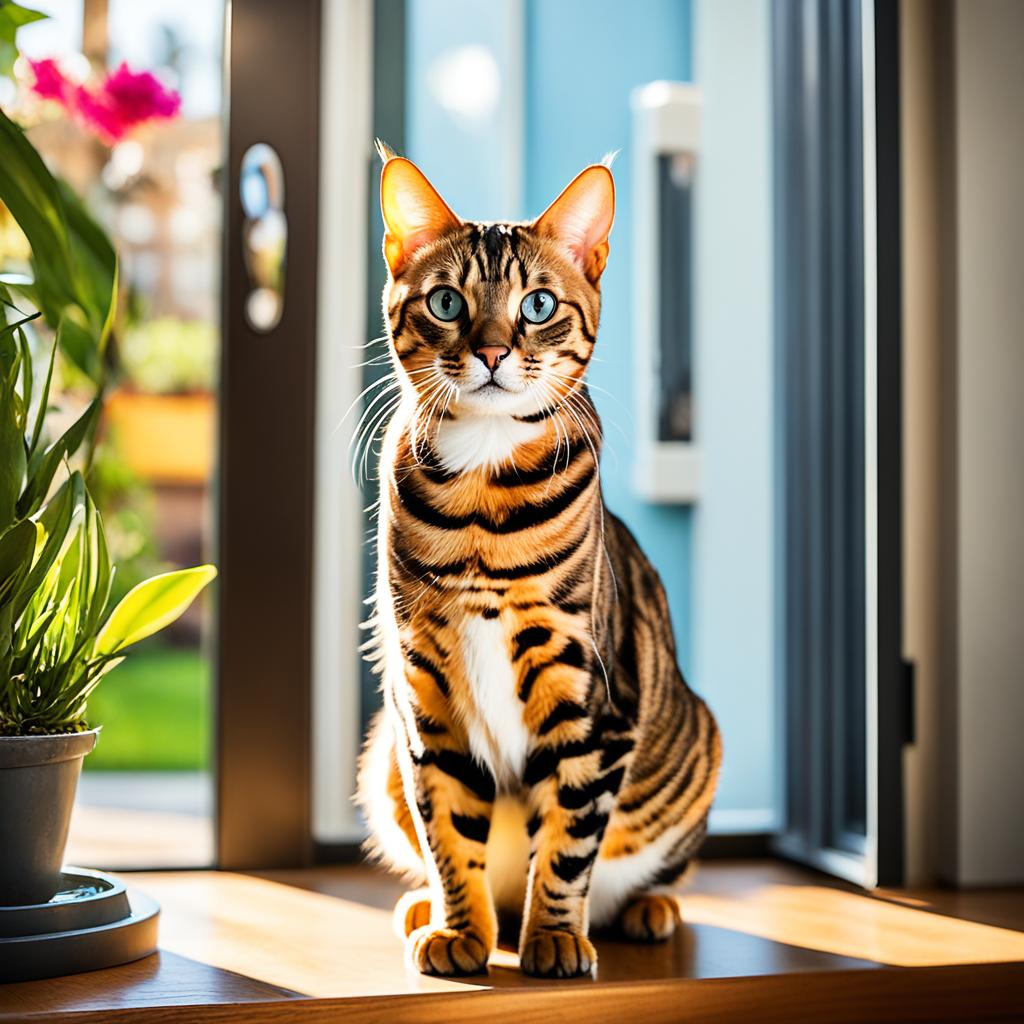
Bengal cats are top-notch at picking up new skills and eagerly so. They are known for being clever and super curious. This makes them love tackling challenges and exploring new things.
Adaptive Nature
The Bengal Cat’s success in training is due to how quickly they adapt. They’re really good at getting used to new places and routines, showing amazing Bengal Cat Adaptability. Simba, for example, learned tricks fast, showing how smart Bengals are.
Desire for Exploration
Bengal cats love to explore, which helps a lot when you’re training them. Their strong urge to see and learn about new things, like opening a cat door, makes teaching them easy. Lucy’s success with leash training shows how well this works.
Preparing for Training: Tools and Environment

Setting up a good training schedule for your Bengal cat is crucial. You need to choose the best cat door, make the environment safe and fun, and get the right training items. These steps ensure your training is both smooth and fun.
Choosing the Right Cat Door
Start Bengal Cat Door Training Tips by picking a door that fits your cat’s needs. Look at how the door is made, how easy it is to install, and the safety it provides. Choose one that your cat can use easily and that is strong and safe.
Creating a Safe and Stimulating Environment
Making a safe space for your cat’s training is key. Remove any dangers and add toys and places for your cat to climb. Bengal cats love to explore and play, so lots of fun items will make them happy and eager to learn.
Gathering Training Aids: Treats and Clickers
Training accessories like treats and a clicker are must-haves. Get tasty treats your Bengal cat will love. Using a clicker to signal good behavior will really help your cat understand what you want.
Useful training tools include:
| Training Aid | Purpose |
|---|---|
| High-Value Treats | Reward and motivate your cat |
| Clicker | Mark desired behaviors clearly |
| Interactive Toys | Keep the training environment stimulating |
| Safety Accessories | Ensure a hazard-free environment |
With the right preparation, Bengal cat training becomes a success. It will be a joyful journey for both you and your cat.
How to Train a Bengal Cat to Use a Cat Door?
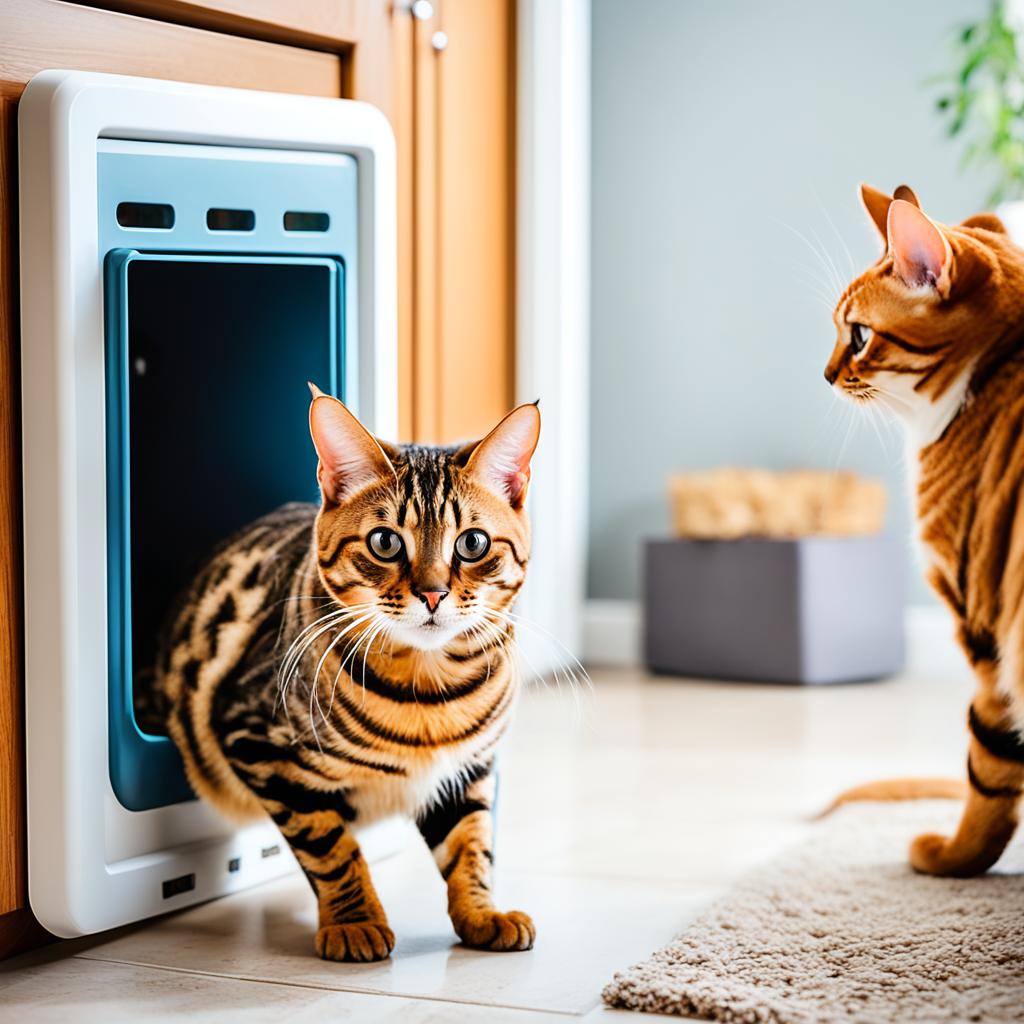
Teaching your Bengal cat to use a cat door is rewarding. You need patience and a positive approach. We’ll cover the best ways to train them step by step.
Gradual Introduction to the Cat Door
Introduce the cat door slowly to your Bengal. At first, keep it open and use treats or toys to get them interested. Let them check it out without forcing anything. With time, they’ll feel ready to push it and explore the other side.
Positive Reinforcement Techniques
Use consistency and rewards to your advantage. Praise them with excitement and give a treat when they make it through the door. This positive approach not only teaches them but also makes the bond between you stronger.
Common Challenges and Solutions
Fear can be a hurdle in training your Bengal to use the door. If noise or movement scares them from using it, gently introduce the door by manually opening and closing it around them. This slow approach helps them get used to it. Remember, watching your cat’s response and making small changes is essential for success.
Step-by-Step Guide to Cat Door Training
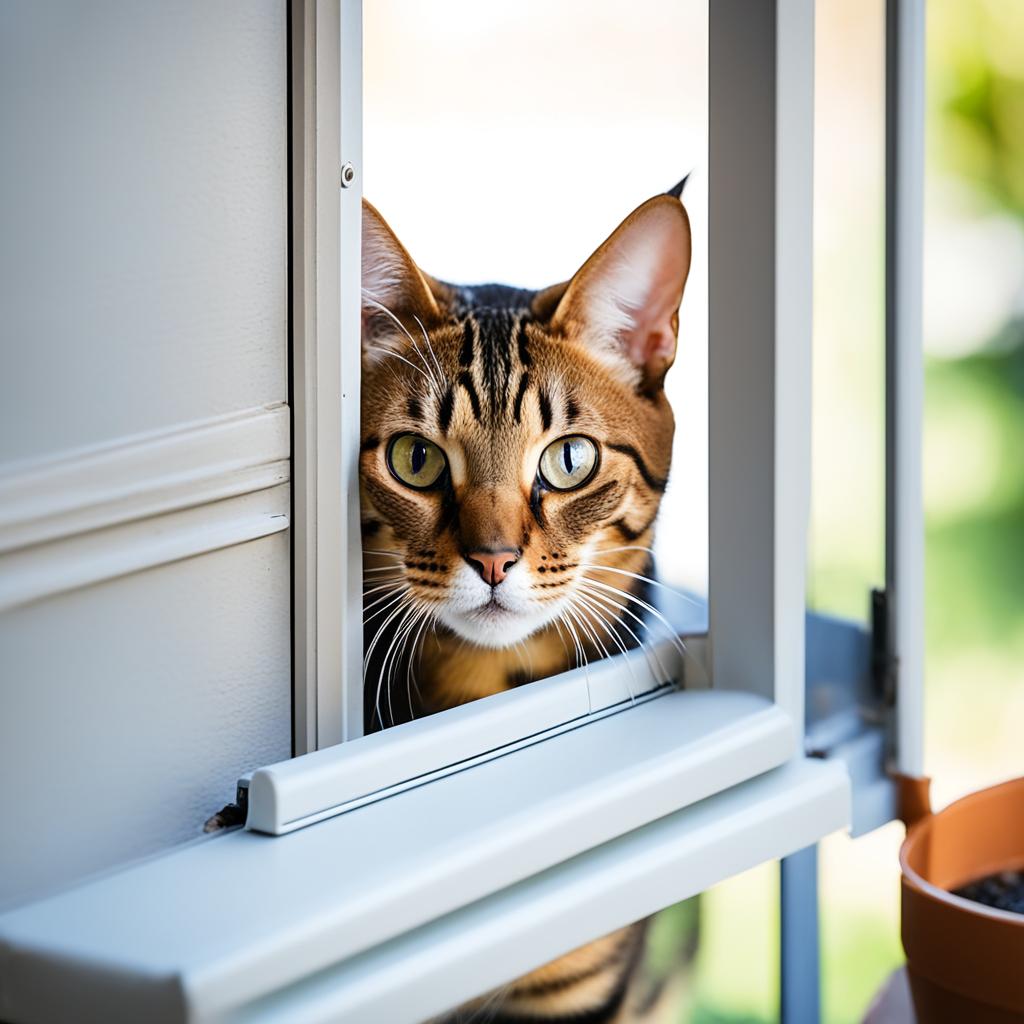
Teaching your Bengal cat to use a cat door is not as hard as it seems. With a few simple steps and consistent training, your cat will learn to love their door.
Initial Introduction and Familiarization
Start by letting your cat look at the door. Keep it open at first. Let them sniff and check it out. You can put their favorite toys or treats nearby to make the door seem fun.
Encouraging Voluntary Interaction
After they are curious, help them see the door is a good thing. Put treats or toys on the other side of the door. This will teach your Bengal that using the door leads to good things. It’s an important part of training.
Building Up to Independent Use
Soon, they’ll get comfy and push it a little more. Each time they nudge it, give them a treat. Always make sure it’s a positive experience. This leads to your cat using the door by themselves.
| Step | Action | Tools |
|---|---|---|
| 1 | Initial Observation | Toys, Treats |
| 2 | Voluntary Interaction | Rewards on the other side |
| 3 | Independent Use | Incremental door closing, Positive reinforcement |
Incorporating Clicker Training for Better Results

Clicker training is a great tool for Bengal cat behavior. It’s fun for both you and your pet. This method, mixed with constant training, often brings great changes.
Basics of Clicker Training
The core of clicker training is simple. With a clicker, you mark the behavior you like. Then, you give your cat a treat. This ties the click with getting a reward. It makes teaching your Bengal cat neat because they’ll know what they did right. This earns them a treat.
Using Clicker Training with the Cat Door
Teaching a Bengal cat to use a cat door needs you to be steady. Start by clicking and treating when your cat just looks at the door. Then, move to rewarding for bigger steps, like going through. The beauty here is that your cat learns fast. They see what they should do to get a treat.
Mix clicker training with other methods to see fast improvements in your cat. This method is precise. It’s great for teaching your cat a lot of things, from using the cat door to much more.
Motivating Your Bengal Cat with Treats and Toys
Teaching Bengal cats new things often needs some fun rewards. These cats are smart and full of energy. They love getting treats and playing with toys as rewards. Choosing the right rewards makes teaching them enjoyable for both of you.
Choosing High-Value Rewards
The right cat treats can boost your Bengal’s learning. Pick ones that make your cat excited. For example, freeze-dried chicken or tuna, and small bits of cooked meat are usually big hits. These treats motivate your Bengal to learn with enthusiasm.
| Reward Type | Benefits | Examples |
|---|---|---|
| Treats | Instant gratification, high motivation | Freeze-dried chicken, tuna flakes, cooked meat |
| Toys | Long-lasting engagement | Feather wands, puzzle toys, interactive balls |
Incorporating Playtime into Training
Adding play to training keeps your Bengal cat interested. Breaks for games keep boredom away. Games like chasing a feather wand or playing with puzzle toys are great. They give your Bengal both exercise and fun rewards.
Addressing Behavioral Issues During Cat Door Training

Teaching your Bengal cat to use a cat door can be both fun and tough. Sometimes cats might be scared or anxious. Let’s talk about how to deal with this during Cat Training Behavioral Challenges.
Handling Fear and Anxiety
To ease your Bengal Cat Anxiety Solutions, make the area around the cat door safe. Use things your cat already loves, like toys or blankets, to introduce the door. Speak softly and calmly to your cat. This will make them feel more comfortable.
Troubleshooting Common Problems
Patience is key when Troubleshooting Bengal Cat Training. Find out what makes your cat worried or upset. If your cat doesn’t understand at first, go slowly. Celebrate every little success with treats or kind words. Being consistent and using positive rewards can help a lot.
- Identify Triggers: Watch and remember what makes your cat anxious.
- Break it Down: Make the training easy to follow and step by step.
- Positive Reinforcement: Reward good behavior with treats, love, and play.
Training for Outdoor and Indoor Use
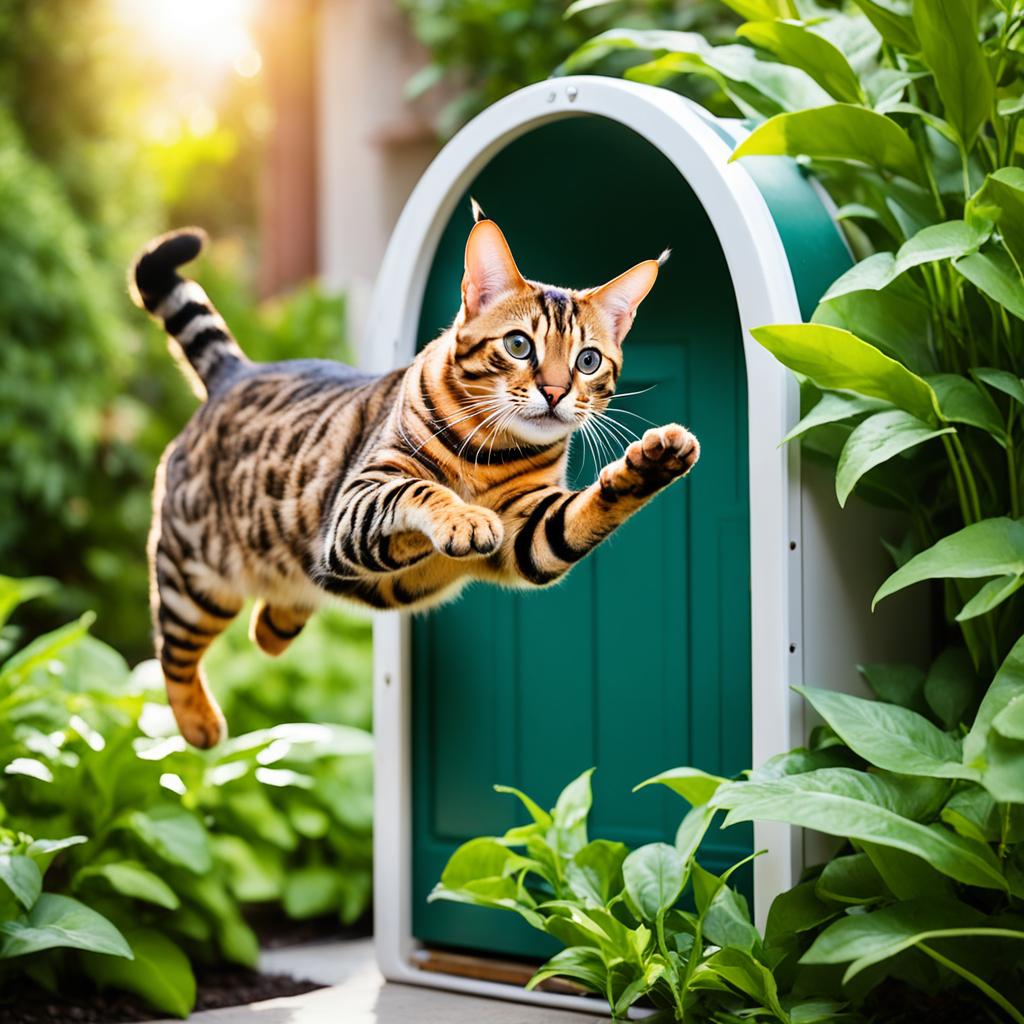
Training your Bengal cat for both indoors and outdoors can be hard, but it’s doable. You need to prepare well and be consistent. We will look at helping your Bengal cat to enjoy the outdoors safely while keeping good habits indoors.
Preparing for Outdoor Exploration
Before venturing out, make sure your cat is okay with a harness and leash. Choose something that fits well to avoid your cat getting away. This lets you both explore the outdoor world safely. Start by letting your cat get used to the backyard. Then move on to other safe places, one step at a time. Letting it happen slowly is key.
Pay attention to the weather when training your Bengal cat. They love the heat, so it’s best to train them when it’s not too hot. Don’t forget to bring water and find shady spots for them to take breaks.
Maintaining Consistency Indoors
Keeping things consistent is crucial for training Bengal cats indoors and outdoors. When you bring your Bengal back inside, keep up a similar routine. Reward good behavior inside just like you do outside. This will help your cat understand what’s expected in any situation.
Bengal cat consistent indoor behavior makes for a peaceful home. Try using regular training, toys, and playtime. Reward good indoor behavior and encourage them to explore. This keeps your Bengal happy both inside and outside.
| Training Aspect | Outdoor Training | Indoor Training |
|---|---|---|
| Equipment | Harness, Leash | Interactive Toys, Treats |
| Environment Prep | Backyard Exploration, Safe Areas | Safe Indoor Space, Consistent Routine |
| Rewards | Treats, Outdoor Play | Treats, Interactive Games |
Conclusion
Bengal cats are full of energy and love to explore. This makes them great for learning new things, like using a cat door. You can teach your Bengal cat to master this using tips from Melis Mandal and her cats, Simba and Lucy.
Training your cat needs patience, consistency, and positive rewards. When you blend these things, you make learning fun for your cat and yourself. This method makes cat training enjoyable for everyone involved.
Bengal cats like to learn and explore. With the right tools and a safe space, your Bengal will enjoy using a cat door. This opens up new adventures for your furry friend. So, start training and have fun together!




